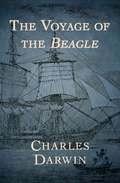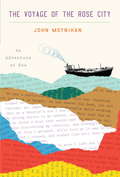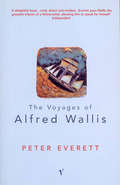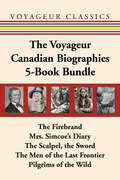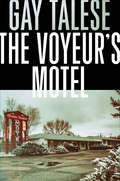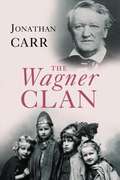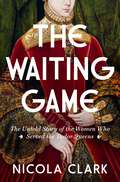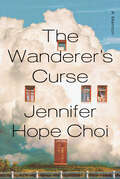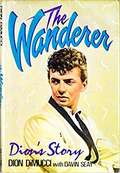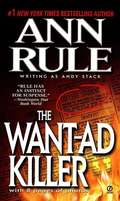- Table View
- List View
The Voyage of the Beagle: Journal Of Researches Into The Natural History And Geology Of The Countries Visited During The Voyage Of H. M. S. Beagle Round The World
by Charles DarwinThe riveting firsthand account of the historic voyage that led to the theory of evolution When the HMS Beagle set sail in 1831, the science of biology was not far removed from the Dark Ages. When the ship returned to England nearly five years later, Charles Darwin had the makings of a theory that would revolutionize our understanding of the natural world. From volcanoes in the Galapagos to the coral reefs of Australia, The Voyage of the Beagle documents the young naturalist&’s encounters with some of the earth&’s most stunning features. Darwin&’s observations of the people, places, and events he experienced make for compelling reading and offer a fascinating window into the intellectual development of his ideas about natural selection. A brilliant travelogue and a revealing glimpse into the Victorian mindset, The Voyage of the Beagle is an indispensable companion volume to On the Origin of Species. This ebook has been professionally proofread to ensure accuracy and readability on all devices.
The Voyage of the Cormorant
by Ken Perkins Christian BeamishChristian Beamish, a former editor at The Surfer's Journal, envisioned a low-tech, self-reliant exploration for surf along the coast of North America, using primarily clothes and instruments available to his ancestors, and the 18-foot boat he would build by hand in his garage. How the vision met reality - and how the two came to shape each other - places Voyage of the Cormorant in the great American tradition of tales of life at sea, and what it has to teach us.
The Voyage of the Golden Rule: An Experiment with Truth
by Albert BigelowIn late March of 1958 four men set sail in a thirty-foot ketch, the Golden Rule, for the nuclear-bomb-testing area in the Marshall Islands. Their sailing was a non-violent protest to the continuation of such tests—tests which could threaten present and future generations with the deadly effects of fallout.Albert Bigelow, master and captain of the Golden Rule, has written a full and articulate account of this project—the reasons behind the sailing, his own difficult personal decision, the two voyages from San Pedro, California, and the government’s opposition that resulted in the imprisonment of captain and crew in Hawaii. He also gives a record of the navigational details of the voyage, including their difficulties in a storm the Coast Guard described as “one of the worst in twenty years.” The reader is given a clear understanding of the theory of non-violence and the author describes some of the other efforts made by the Committee for Non-Violent Action Against Nuclear Weapons and by the crew who later sailed another vessel, the Phoenix, right into the testing area.First published in 1959, THE VOYAGE OF THE GOLDEN RULE is an honest and inspiring record of a remarkable voyage and the men who made it. It is an important account of a noble action, one which focused the attention of the world and its governments on a problem that must be solved immediately if mankind is to survive. Above all, it is a calm and eloquent plea for peace on earth by a man who felt that it was “time to do something about peace, not just talk about peace.”
The Voyage of the Rose City: An Adventure at Sea
by John MoynihanA gripping, beautifully told story of a young man's coming-of-age at sea When John Moynihan decided to ship out in the Merchant Marine during the summer of his junior year at Wesleyan University, his father, Senator Daniel Patrick Moynihan, was not enthusiastic: As a young man, before joining the U.S. Navy, Pat Moynihan had worked the New York City docks and knew what his son would encounter. However, John's mother, Elizabeth, an avid sailor, found the idea of an adventure at sea exciting and set out to help him get his Seaman's Papers. When John was sworn in, he was given one piece of advice: to not tell the crew that his father was a United States senator.The job ticket read "forty-five days from Camden, New Jersey, to the Mediterranean on the Rose City," a supertanker. As the ship sailed the orders changed, and forty-five days became four months across the equator, around Africa, across the Indian Ocean, and up to Japan--a far more perilous voyage than John or his mother had imagined. The physical labor was grueling, and outdated machinery aboard the ship, including broken radar, jeopardized the lives of the crew. They passed through the Straits of Malacca three times, with hazardous sailing conditions and threats of pirates. But it was also the trip of a lifetime: John reveled in the natural world around him, listened avidly to the tales of the old timers, and even came to value the drunken camaraderie among men whose only real family was one another. A talented artist, John drew what he saw and kept a journal on the ship that he turned into his senior thesis when he returned to Wesleyan the following year.A few years after John died in his early forties, the result of a reaction to acetaminophen, his mother printed a limited edition of his journal illustrated with drawings from his notebooks. Encouraged by the interest in his account of the voyage, she agreed to publish the book more widely. An honestly written story of a boy's coming into manhood at sea, The Voyage of the Rose City is a taut, thrilling tale of the adventure of a lifetime.From the Hardcover edition.
The Voyages Of Alfred Wallis
by Peter EverettAlfred Wallis was born in 1855 and died in a workhouse in Cornwall in 1942. A fisherman, sailing from Newlyn, Mousehole and St Ives, he began to paint in the 1920s - strange, brilliant pictures of ships and the sea. In 1928 he was discovered in St Ives by Ben Nicholson and Christopher Wood and for the rest of his life, alone in his tiny cottage, attacked by periods of madness, he painted furiously. In MATISSE'S WAR, Peter Everett explored the psyche of one of the most celebrated painters of our age. Here he performs a similar feat for another artist, one who knew no fame in his lifetime but whose paintings have found vast popularity since his death.
The Voyages of Captain James Cook: The Illustrated Accounts of Three Epic Voyages
by James King John Hawkesworth James Cook Georg ForsterThe first-ever illustrated account of the explorer and cartographer’s epic eighteenth-century Pacific voyages, complete with excerpts from his journals.This is history’s greatest adventure story. In 1766, the Royal Society chose prodigal mapmaker and navigator James Cook to lead a South Pacific voyage. His orders were to chart the path of Venus across the sun. That task completed, his ship, the HMS Endeavour, continued to comb the southern hemisphere for the imagined continent Terra Australis. The voyage lasted from 1768 to 1771, and upon Cook’s return to London, his journaled accounts of the expedition made him a celebrity. After that came two more voyages for Cook and his crew—followed by Cook’s murder by natives in Hawaii. The Voyages of Captain James Cook reveals Cook’s fascinating story through journal excerpts, illustrations, photography, and supplementary writings.During Cook’s career, he logged more than 200,000 miles—nearly the distance to the moon. And along the way, scientists and artists traveling with him documented exotic flora and fauna, untouched landscapes, indigenous peoples, and much more. In addition to the South Pacific, Cook’s voyages took him to South America, Antarctica, New Zealand, the Pacific Coast from California to Alaska, the Arctic Circle, Siberia, the East Indies, and the Indian Ocean. When he set out in 1768, more than one-third of the globe was unmapped. By the time Cook died in 1779, he had created charts so accurate that some were used into the 1990s.The Voyages of Captain James Cook is a handsome illustrated edition of Cook’s selected writings spanning his Pacific voyages, ending in 1779 with the delivery of his salted scalp and hands to his surviving crewmembers. It’s an enthralling read for anyone who appreciates history, science, art, and classic adventure.
The Voyageur Canadian Biographies 5-Book Bundle: The Firebrand / Mrs. Simcoe's Diary / The Scalpel, the Sword / The Men of the Last Frontier / Pilgrims of the Wild
by Julie Allan Grey Owl Michael Gnarowski James Polk William Kilbourn Ronald Stagg Mary Quayle Innis Elizabeth Posthuma Simcoe Hugh Eayrs Norman Bethune Allan Susan Ostrovsky Sydney GordonVoyageur Classics is a series of special versions of Canadian classics, with added material and new introductory notes. In this bundle we find five biographical and autobiographical titles that shed light on some of Canada’s most important figures at crucial times in the country’s development. William Kilbourn brings to life the rebel Canadian hero William Lyon Mackenzie: able political editor, first mayor of Toronto, and the gadfly of the House of Assembly. The Scalpel, the Sword celebrates the turbulent career of Dr. Norman Bethune, a brilliant surgeon, campaigner for socialized medicine, and communist. Elizabeth Simcoe’s diary, describing Canada from 1791 to 1796, is history written as it was being made, an account instilled with excitement and delight. And finally, two titles by the legendary Grey Owl tell his own astonishing story and advocate for a closeness with and respect for nature. Each of these books is an essential classic of Canadian literature. Includes The Firebrand Mrs. Simcoe’s Diary The Scalpel, the Sword The Men of the Last Frontier Pilgrims of the Wild
The Voyeur's Motel (Books That Changed the World)
by Gay TaleseThe controversial chronicle of a motel owner who secretly studied the sex lives of his guests by the renowned journalist and author of Thy Neighbor’s Wife.On January 7, 1980, in the run-up to the publication of his landmark bestseller Thy Neighbor’s Wife, Gay Talese received an anonymous letter from a man in Colorado. “Since learning of your long-awaited study of coast-to-coast sex in America,” the letter began, “I feel I have important information that I could contribute to its contents or to contents of a future book.” The man—Gerald Foos—hen divulged an astonishing secret: he had bought a motel outside Denver for the express purpose of satisfying his voyeuristic desires. Underneath its peaked roof, he had built an “observation platform” through which he could peer down on his unwitting guests.Over the years, Foos sent Talese hundreds of pages of notes on his guests, work that Foos believed made him a pioneering researcher into American society and sexuality. Through his Voyeur’s motel, he witnessed and recorded the harsh effects of the war in Vietnam, the upheaval in gender roles, the decline of segregation, and much more. In The Voyeur’s Motel. “the reader observes Talese observing Foos observing his guests.” An extraordinary work of narrative journalism, it is at once an examination of one unsettling man and a portrait of the secret life of the American heartland over the latter half of the twentieth century (Daily Mail, UK).“This is a weird book about weird people doing weird things, and I wouldn’t have put it down if the house were on fire.” —John Greenya, Washington Times
The Vulnerable Observer: Anthropology That Breaks Your Heart
by Ruth BeharEloquently interweaving ethnography and memoir, award-winning anthropologist Ruth Behar offers a new theory and practice for humanistic anthropology. She proposes an anthropology that is lived and written in a personal voice. She does so in the hope that it will lead us toward greater depth of understanding and feeling, not only in contemporary anthropology, but in all acts of witnessing.
The Wagner Clan: The Saga of Germany's Most Illustrious and Infamous Family
by Jonathan CarrollA well-researched account of the composer Richard Wagner's later life and the lives of his contentious descendants down to the present.
The Wagner Operas
by Ernest NewmanIn this classic guide, the foremost Wagner expert of our century discusses ten of Wagner's most beloved operas, illuminates their key themes and the myths and literary sources behind the librettos, and demonstrates how the composer's style changed from work to work. Acclaimed as the most complete and intellectually satisfying analysis of the Wagner operas, the book has met with unreserved enthusiasm from specialist and casual music lover alike. Here, available for the first time in a single paperback volume, is the perfect companion for listening to, or attending, The Flying Dutchman, Tannhäuser, Lohengrin, Tristan and Isolde, Die Meistersinger, the four operas of the Ring Cycle, and Parsifal. Newman enriches his treatment of the stories, texts, and music of the operas with biographical and historical materials from the store of knowledge that he acquired while completing his numerous books on Wagner, including the magisterial Life of Richard Wagner. The text of The Wagner Operas is filled with hundreds of musical examples from the scores, and all the important leitmotifs and their interrelationships are made clear in Newman's lucid prose. "This is as fine an introduction as any ever written about a major composer's masterpieces. Newman outlines with unfailing clarity and astuteness each opera's dramatic sources, and he takes the student through the completed opera, step by step, with all manner of incidental insight along the way. "--Robert Bailey, New York University
The Wagon and Other Stories from the City
by Martin PreibMartin Preib is an officer in the Chicago Police Department--a beat cop whose first assignment as a rookie policeman was working on the wagon that picks up the dead. Over the course of countless hours driving the wagon through the city streets, claiming corpses and taking them to the morgue, arresting drunks and criminals and hauling them to jail, Preib took pen to paper to record his experiences. Inspired by Preib's daily life as a policeman, The Wagon and Other Stories from the City chronicles the outer and inner lives of both a Chicago cop and the city itself. The book follows Preib as he transports body bags, forges an unlikely connection with his female partner, trains a younger officer, and finds himself among people long forgotten--or rendered invisible--by the rest of society. Preib recounts how he navigates the tenuous labyrinths of race and class in the urban metropolis, such as a domestic disturbance call involving a gang member and his abused girlfriend or a run-in with a group of drunk yuppies. As he encounters the real and imagined geographies of Chicago, the city reveals itself to be not just a backdrop, but a central force in his narrative of life and death. Preib's accounts, all told in his breathtaking prose, range from noir-like reports of police work to streetwise meditations on life and darkly humorous accounts of other jobs in the city's service industry. Here, Preib's universe of police officers, criminals, and victims--and everyone in between--comes alive in ways that readers will long remember.
The Waifs
by Rena BriandA fascinating story for anyone interested in the adoption of vulnerable mixed-race children abandoned in the aftermath of war. When Rena Briand adopted Tuyen, a Vietnamese orphan, and successfully brought her to Australia, dozens of families aspired to do the same. Rena Briand's "The Waifs" is a compelling story about battling officialdom with resilience and determination. A tale on how a handful of compassionate women fought to get a few Vietnamese waifs to Australia. Their opponents were formidable - conniving politicians hypocritical church leaders racist social workers and the phony "charitables" of Toorak. A moving and courageous story.
The Waiting Game: The Untold Story of the Women Who Served the Tudor Queens: A History
by Nicola ClarkA colorful and authoritative narrative history of the often-overlooked—yet hugely influential—figures of the Tudor court: the ladies-in-waiting.Every Tudor Queen had ladies-in-waiting. They were her confidantes and her chaperones. Only the Queen's ladies had the right to enter her most private chambers, spending hours helping her to get dressed and undressed, caring for her clothes and jewels, listening to her secrets. But they also held a unique power. A quiet word behind the scenes, an appropriately timed gift, a well-negotiated marriage alliance were all forms of political agency wielded expertly by women. The Waiting Game explores the daily lives of ladies-in-waiting, revealing the secrets of recruitment, costume, what they ate, where (and with whom) they slept. We meet María de Salinas, who traveled to England with Catherine of Aragon when just a teenager and spied for her during the divorce from Henry VIII. Anne Boleyn's lady-in-waiting Jane Parker was instrumental in the execution of not one, but two queens. And maid-of-honor Anne Basset kept her place through the last four consorts, negotiating the conflicting loyalties of her birth family, her mistress the Queen, and even the desires of the King himself. As Henry changed wives—and changed the very fabric of the country's structure besides—these women had to make choices about loyalty that simply didn't exist before. The Waiting Game is the first time their vital story has been told.
The Wall Between Us: Notes from the Holy Land
by Matthew Small&“The biology of Israel/Palestine simply and beautifully revealed,&” from the author of Down and Out Today: Notes from the Gutter (Jon Snow, journalist and presenter). Writer Matthew Small traveled to the Holy Land to further his understanding of the enduring conflict between Israel and Palestine. While there, he discovered beauty, fear and suffering like nowhere else in the world. In these honest and evocative reflections, Small retells his experiences of crossing into the West Bank to work the olive harvest with Palestinian farmers. He relates his encounters with organizations that are determinedly working to sow the seeds of peace in soils that are deeply scarred by suffering and war. While reliving these unforgettable experiences, through his writing he struggles to find why the wall between these two groups of people exists. Deciding to join a group of international and Israeli volunteers, Small attempts to show that, despite the ongoing occupation, peace is not lost, but still to be discovered. &“Matthew Small, despite the horror of both the war, and the wall, works and travels both sides of the divide, and brings us to an understanding of where the seeds of peace can yet be found.&”—Jon Snow, journalist and presenter &“What is really refreshing about this book is the way Small writes from a very personal perspective, often admitting in his diary entries that he&’s unsure what to write or how he feels about the situation. His emotion surrounding his visit and the people living amongst the occupation every day is portrayed in a gritty, raw way.&”—The Bookbag
The Wall of Life: Pictures and Stories from This Marvelous Lifetime
by Shirley MacLaineAcademy Award-winning actress and New York Times bestselling author Shirley MacLaine shares a dazzling memoir in photographs, chronicling her extraordinary life with 150+ images from her personal archiveWith more than seventy years on the silver screen, Shirley MacLaine has, as she says, seen it all, done it all, been everywhere, and met everyone. Since making her Hollywood debut in 1955, her popularity has only grown as she&’s amassed a stunning collection of awards and written multiple bestselling memoirs.Now, at ninety years old, MacLaine has more stories to tell and the pictures to bring them to life. By introducing readers to her extensive photo collection—which she calls her &“wall of life&”—MacLaine reveals both intimate family memories and images with some of the most significant figures from entertainment and politics. With wit and charm, she reflects on each photo, exploring ambition, love, friendship, motherhood, art, political activism, curiosity, and more.Charting the course of her remarkable life and career, MacLaine shares both early memories (her childhood with her brother, Warren Beatty; her decision to leave for New York City at age sixteen; her early work dancing on Broadway) as well as remembrances of her days in the public eye (campaigning for George McGovern, traveling to meet political luminaries, starring in legendary film roles, and developing an interest in spirituality).Along the way, readers gain greater insight into figures such as Frank Sinatra, Dean Martin, Bob Fosse, Jack Nicholson, the Dalai Lama, Fidel Castro, Mikhail Baryshnikov, and many more. Whether she's sharing what advice Elvis Presley asked her for, how she consoled close friend Elizabeth Taylor after the death of her husband, or which head of state she discussed UFOs with, MacLaine offers her most visual and delightful book yet, giving readers an unprecedented glance into a life like no other.
The Wall: Growing Up Behind the Iron Curtain
by Peter SísThrough journals, maps, and dreamscapes, Peter Sís shows what life was like for a child who loved to draw, proudly wore the red scarf of a Young Pioneer, stood guard at the giant statue of Stalin, and believed whatever he was told to believe. But adolescence brought questions. Cracks began to appear in the Iron Curtain, and news from the West slowly filtered into the country. Sís learned about beat poetry, rock 'n' roll, blue jeans, and Coca-Cola. He let his hair grow long, secretly read banned books, and joined a rock band. Then came the Prague Spring of 1968, and for a teenager who wanted to see the world and meet the Beatles, this was a magical time. It was short-lived, however, brought to a sudden and brutal end by the Soviet-led invasion. But this brief flowering had provided a glimpse of new possibilities- creativity could be discouraged but not easily killed. By joining memory and history, Sís takes us on his journey: from infant with paintbrush in hand to young man borne aloft by the wings of his art. <P><P> Winner of the Sibert Medal
The Wanderer's Curse: A Memoir
by Jennifer Hope ChoiA Korean mother runs off to Alaska, sparking a greater season of wandering. Could her daughter be destined for the same? When Jennifer Hope Choi first stumbled upon the “curse” known as yeokmasal—an allegedly inheritable affliction causing one to roam farther and farther from home—she immediately consulted her mother. “Oh yeah,” Umma quipped. “I have that.” Technically this wasn’t a revelation. Since 2007, the no-nonsense open-heart surgery nurse had moved suddenly from the Golden State to the Last Frontier, shuttling over the next decade through seven states. For much of her adulthood, Choi had fancied herself nothing like her immigrant mother, late-blooming vagabond spirit and all—until life in Brooklyn imploded, spurring her to relocate to South Carolina and reckon with startling truths. Artmaking had left her in debt, single, and jobless. Questions hovered, gathering ragged like fractus clouds: Was it time to give up writing? Would she ever have a place of her own to call home? Or was she doomed to bunk up with Umma in the Deep South indefinitely? This probing memoir follows Choi through her many former homes, from a crumbling Chinatown tenement to a haunted museum in Georgia. Connections emerge, between her curious trajectory and idiosyncratic Korean identity narratives: a mystical Korean dog breed, pro golfers, modern Korean cults, the four pillars of destiny, and Korean American art. One question lingers throughout her search: What might be gained from living in residence with uncertainty? Told with whip-smart sensibility, The Wanderer’s Curse is an electric mother-daughter story, exploring ideas of belonging, self-determination, and possibility, leaving readers to wonder what we take with us generation to generation, what we wish we could leave behind, and how we move on.
The Wanderer: Dion's Story
by Davin Seay Dion DiMucciThe pop music idol chronicles his life and career from his troubled youth in the Bronx to his rise to fame--tainted by heroin addiction and alcoholism--to his newfound spiritual awakening
The Wandering Pine: Life As A Novel
by Per Olov Enquist Deborah Bragan-TurnerWhen everything began so well, how could it turn out so badly? A blisteringly frank autobiographical novel by Sweden's great man of letters - for readers of K. O. Knausgaard's My Struggle."Some life. Some novel . . . Wonderful, brave, evocative . . . It is a remarkable story, and Enquist is remarkably frank in narrating every last detail" HeraldWhat was it about Hjoggböle, a farming village in the northernmost part of Sweden, that created so many idiots - and writers? There was nothing to indicate that P.O. Enquist would be stricken by an addiction to writing. Nothing in his family - honest, hardworking people. Not a trace of poetry. And yet he worked his way, via journalism, novels and plays, to the centre of Swedish politics and cultural life. His books garnered prize after prize. His plays ran for decades and premiered on Broadway. Why then, living with a new wife in Paris, does he hole up in their palatial Champes-Élysées apartment, talking only to his cat? How is it that he wakes to find himself in an uncoupled carriage on a railway siding in Hamburg, two - or was it three? - days after the first-night party finished? And what is it that drives him to run shoeless through the deep January snow of an Icelandic plain, leaving the lights of the drying out clinic far behind? Narrating in the third person, as if he were merely a character in the eventful, perplexing and ultimately triumphantly redemptive drama of his own life, P.O. Enquist is as elliptical as Karl Ove Knausgaard is exhaustive. Clear-eyed, rueful, written with elegance and humour, this is the singular story of a remarkable man.
The Wandering Pine: Life as a Novel
by Per Olov EnquistWhen everything began so well, how could it turn out so badly? A blisteringly frank autobiographical novel by Sweden's great man of letters - for readers of K. O. Knausgaard's My Struggle."Some life. Some novel . . . Wonderful, brave, evocative . . . It is a remarkable story, and Enquist is remarkably frank in narrating every last detail" HeraldWhat was it about Hjoggböle, a farming village in the northernmost part of Sweden, that created so many idiots - and writers? There was nothing to indicate that P.O. Enquist would be stricken by an addiction to writing. Nothing in his family - honest, hardworking people. Not a trace of poetry. And yet he worked his way, via journalism, novels and plays, to the centre of Swedish politics and cultural life. His books garnered prize after prize. His plays ran for decades and premiered on Broadway. Why then, living with a new wife in Paris, does he hole up in their palatial Champes-Élysées apartment, talking only to his cat? How is it that he wakes to find himself in an uncoupled carriage on a railway siding in Hamburg, two - or was it three? - days after the first-night party finished? And what is it that drives him to run shoeless through the deep January snow of an Icelandic plain, leaving the lights of the drying out clinic far behind? Narrating in the third person, as if he were merely a character in the eventful, perplexing and ultimately triumphantly redemptive drama of his own life, P.O. Enquist is as elliptical as Karl Ove Knausgaard is exhaustive. Clear-eyed, rueful, written with elegance and humour, this is the singular story of a remarkable man.
The Want-Ad Killer
by Ann RuleKathy Sue Miller was a beautiful 16-year-old innocent when she answered the inviting job ad. Even the police were shocked when they found her...
The War After the War: A Warrior's Journey Home
by John Wesley FisherThe War After the War maps the author's 37 year journey from his tour in Vietnam to the recovery of peace within his soul.
The War Against Tuberculosis: Samuel G. Dixon and the Rise of Modern Public Health in Pennsylvania (Keystone Books)
by James E. HigginsIn 1905, sanitary conditions in Pennsylvania were appalling. Thousands of children died of preventable and curable diseases, tens of thousands in the coal regions hacked themselves to death from black lung disease, and pollution in the commonwealth’s water killed tens of thousands more. In the wake of an alarming typhoid outbreak in Butler, the Pennsylvania legislature formed a modern state department of health. At its head was Samuel G. Dixon, who would rise to fame as one of the most respected public health experts of his day.While the legislation that created Pennsylvania’s department of health cleared space for its aggressive action, it was Dixon’s deft political touch and keen insight that enabled the department to avoid destruction at the hands of a people notoriously hostile to government encroachment. As commissioner, Dixon constructed the world’s largest, most sophisticated system of tuberculosis controls, with thousands of beds in three great sanatoria. As his reputation grew, Dixon was recognized as one of the nation’s greatest public health reformers and a champion of technology as the answer to great societal problems. At the same time, Dixon was a eugenicist who helped author a marriage law prohibiting unions between the diseased, those with intellectual disabilities or psychiatric disorders, alcoholics, and the “unfit.”This compelling history of Pennsylvania’s first commissioner of public health provides a fascinating view into the changes wrought by germ theory and the public health efforts that stemmed from it during the Progressive Era in the United States.
The War Before: The True Life Story of Becoming a Black Panther, Keeping the Faith in Prison & Fighting for Those Left Behind
by Safiya BukhariAn inspiring memoir from a legendary activist and political prisoner that &“reminds us of the sheer joy that comes from resisting civic wrongs&” (Truthout). In 1968, Safiya Bukhari witnessed an NYPD officer harassing a Black Panther for selling the organization&’s newspaper on a Harlem street corner. The young pre-med student felt compelled to intervene in defense of the Panther&’s First Amendment right; she ended up handcuffed and thrown into the back of a police car. The War Before traces Bukhari&’s lifelong commitment as an advocate for the rights of the oppressed. Following her journey from middle-class student to Black Panther to political prisoner, these writings provide an intimate view of a woman wrestling with the issues of her time—the troubled legacy of the Panthers, misogyny in the movement, her decision to convert to Islam, the incarceration of outspoken radicals, and the families left behind. Her account unfolds with immediacy and passion, showing how the struggles of social justice movements of the past have paved the way for the progress—and continued struggle—of today. With a preface by Bukhari&’s daughter, Wonda Jones, a forward by Angela Y. Davis, and edited by Laura Whitehorn, The War Before is a riveting look at the making of an activist and the legacy she left behind.
